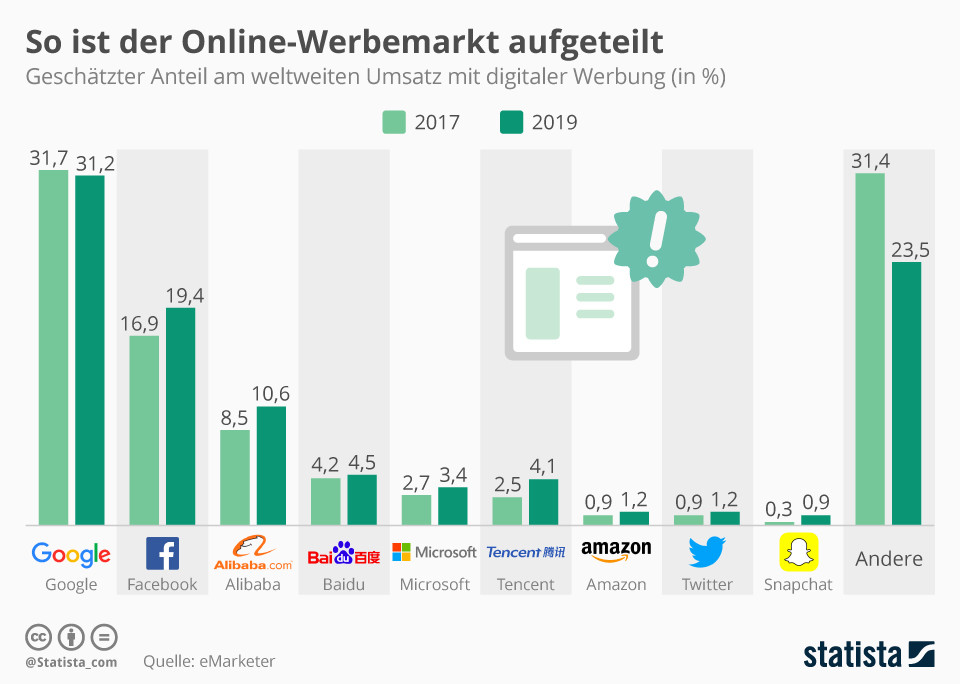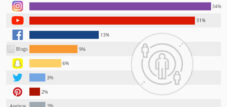+++ This is how the online advertising market is divided +++ Snapchat has a marketing problem +++ Instagram and YouTube are the most lucrative for influencers +++ This is how big Google's advertising business is +++ The advertising duopoly +++ Facebook's growing weight online -Advertising market +++ Instagram is becoming more and more advertising +++ Internet advertising is disruptive +++ Customers who bought this item also bought... +++ Individualized advertising is booming +++ Where products are advertised +++
Google and Facebook account for about half of digital advertising revenue, eMarketer The two tech giants owe this to the dominant market position of their online platforms (including Google, YouTube, Facebook and Instagram). Alibaba follows in third place. The analysts assume that the Chinese will increase their share of online advertising sales to over ten percent by 2019. Snapchat is also trending towards growth. The company's advertising revenue could triple, even if only from 0.3 to 0.9 percent.
Snapchat has a marketing problem
The key to Facebook's resounding economic success is advertising. Social Media Examiner, hardly any social media marketing specialist does not rely on the largest social network in the world. Things are different with Snapchat. Only eight percent of those surveyed work with the messaging service, which is used by 191 million people every day. This is not good news for Snap, the company behind the app. If it stays that way, it will be difficult to ever get out of the red.
Instagram and YouTube are the most lucrative for influencers
Goldmedia, influencers from Germany, Austria and Switzerland (DACH) generate 34 percent of their sales via Instagram. The second most important channel is YouTube with a sales share of 31 percent. Facebook or Snapchat, on the other hand, only play a minor role. Analysts estimate the total volume of influencer sales for 2017 to be around 560 million euros. The market in the DACH region is expected to grow to almost one billion euros by 2020.
That's how big Google's advertising business is
The company owes the fact that Alphabet is doing well economically to its search engine. In the second quarter of 2017 alone, Google generated an operating profit of $7.8 billion. In 2016, online advertising revenue was $79.4 billion. In Germany, on the other hand, 22 billion US dollars were spent on advertising in the same period - and not just online, but across all channels. Google only has to subordinate itself to the USA when it comes to advertising volume.
The advertising duopoly
The progressive shift of advertising from traditional media to the Internet not only results in a redistribution of advertising revenue from publishers, TV and radio stations to online media, it also results in an unprecedented concentration of the advertising market.
The dominant market position of the online platforms operated by Google and Facebook (including Google, YouTube, Facebook and Instagram) ensures that, according to a current estimate will collect around 60 percent of global spending on online advertising this year. As the graphic from Statista shows, this means that one in four euros spent worldwide on advertising – online or offline – now ends up with the two giants from Silicon Valley.
Facebook's growing weight in the online advertising market
Bad times for Facebook: After it became known that the company Cambridge Analytica used the social media giant's data in both the election campaign for US President Donald Trump and for Brexit, the share price fell and users turned away.
Facebook has now placed several full-page print ads in which company boss Mark Zuckerberg apologizes to users. But to put it simply, collecting data to target targeted advertising is Facebook's business model. “Data misuse is a feature, not a bug,” as Ethan Zuckerman writes for The Atlantic . Except that in this case it wasn't selling shoes, but rather influencing political opinions.
As the graphic from Statista shows, the social network's advertising business has grown significantly in recent years. In 2017, advertising revenue accounted for almost 20 percent of the total global online advertising market. To what extent the current debate will influence this in the future remains to be seen. The first major advertising customers are already turning away or at least temporarily stopping their advertising.
Instagram is becoming more and more promotional
Instagram has become a well-oiled advertising machine. This is shown by data from Influencer DB , a database for Instagram influencers. Accordingly, the number of sponsored posts rose to over 100,000 per month in August. The analysis is based on ten selected tags that are used to mark sponsored content. In fact, the number of advertising posts is likely to be significantly higher, especially since many posts are not marked as sponsored at all.
Internet advertising is disruptive
Which advertising is annoying and which is helpful? Statista investigated this question in a recent survey. It emerged that the majority of respondents find almost all forms of Internet advertising annoying - this is particularly true for advertising videos on news websites and advertising in e-mail newsletters. Germans find TV commercial breaks even more stressful, with 66 percent finding it annoying. On the other hand, advertising in stores, as direct mail and in daily newspapers is seen as helpful.
Customers who bought this product also bought …
Customers who bought this item also bought product X and product Y. Online stores often suggest other items for customers to purchase, but does this form of advertising actually work? According to a current Statista survey, apparently so. 60 percent of online shoppers surveyed generally pay attention to suggestions from shops as to which items might be of interest to them - and the majority find that the suggestions fit well with their purchasing interests. What's more, of those who pay attention to suggested items, 39 percent say they buy such products occasionally or even frequently.
Individualized advertising is booming
Programatic advertising is used to play personalized advertising on the basis of user data. In 2016, sales of 592 million euros were generated in Germany with this form of online advertising according to the Federal Association of Digital Business (BVDW). For the current year, the BVDW experts expect a market volume of 864 million euros, which corresponds to an increase of 46 percent. Stefan Zarnic (Burda Community Network), Chairman of the Programmatic Advertising focus group in BVDW, explains: "The rapid development of Programmatic Advertising continues and exceeds our own forecasts."
Where products are advertised
Have you ever noticed that completely different products are advertised depending on whether you are listening to the radio or surfing the Internet? This is not only due to personalized advertising on the Internet, but also to how much advertising budget the individual industries invest in these channels.
In Germany you are confronted with at least 2,500 advertising messages every day, some even say 10,000. However, only a fraction of it is noticed. Nevertheless, studies assume that advertising investments will continue to increase in the future.
The following graphic shows which industries, measured in terms of their advertising investments , are most strongly represented in radio and the Internet. Retail and shipping, for example, are particularly active on the radio. On the Internet, however, advertising investments in this industry are significantly lower at 156 million. They correspond to just a quarter of radio spending. The financial sector takes first place online; its advertising budget in 2016 was almost 270 million euros.


